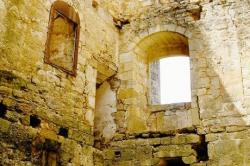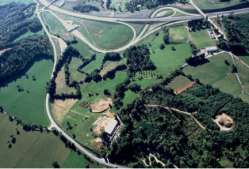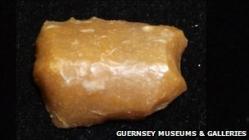- 08 JUIN
- FRANCE –  Blanquefort-sur-Briolance - En 2010, le tournage de l'émission « Des racines et des ailes » avait mis sous le feu des projecteurs les travaux de restauration du château de Blanquefort-sur-Briolance et le chantier participatif qui avait alors mobilisé tout le village pour dégager une tour du XVe siècle de ses gravats. Le chantier de restauration va se poursuivre cet été. Après la restauration des contreforts des terrasses Est et Ouest, les travaux vont porter, conformément au plan de restauration défini par l'architecte des Bâtiments de France, sur la consolidation de la tour du XVe siècle dégagée l'année dernière, et la mise hors d'eau du donjon. Parallèlement, un nouveau chantier participatif va être organisé au cours de l'été. Il s'agira cette fois de dégager la salle voûtée découverte l'année dernière sous la terrasse Ouest et de fouiller méthodiquement ses gravats. Selon Gilles Séraphin, éminent spécialiste en archéologie médiévale venu sur le site l'été dernier, il pourrait s'agir de la prison du château médiéval originel datant du XIIe siècle. Ce nouveau chantier participatif se déroulera du 13 au 15 juillet prochain.
Blanquefort-sur-Briolance - En 2010, le tournage de l'émission « Des racines et des ailes » avait mis sous le feu des projecteurs les travaux de restauration du château de Blanquefort-sur-Briolance et le chantier participatif qui avait alors mobilisé tout le village pour dégager une tour du XVe siècle de ses gravats. Le chantier de restauration va se poursuivre cet été. Après la restauration des contreforts des terrasses Est et Ouest, les travaux vont porter, conformément au plan de restauration défini par l'architecte des Bâtiments de France, sur la consolidation de la tour du XVe siècle dégagée l'année dernière, et la mise hors d'eau du donjon. Parallèlement, un nouveau chantier participatif va être organisé au cours de l'été. Il s'agira cette fois de dégager la salle voûtée découverte l'année dernière sous la terrasse Ouest et de fouiller méthodiquement ses gravats. Selon Gilles Séraphin, éminent spécialiste en archéologie médiévale venu sur le site l'été dernier, il pourrait s'agir de la prison du château médiéval originel datant du XIIe siècle. Ce nouveau chantier participatif se déroulera du 13 au 15 juillet prochain.
http://www.sudouest.fr/2011/06/08/des-fouilles-archeologiques-prevues-cet-ete-au-chateau-420164-3630.php
- FRANCE –  Tintignac - « Une agglomération éclatée avec des espaces publiques dispersés » voilà ce qu’était le site du sanctuaire de Tintignac d’après Christophe Maniquet, archéologue limogeois de l’Inrap qui depuis 2001 dirige les fouilles et les recherches. On lui doit la mise à jour des désormais célèbres Carnyx dont l’état de conservation permet dorénavant de créer des reproductions. Il n’en existait que deux exemplaires non complets en Europe alors que cet instrument guerrier de musique, avait été souvent reproduit sur les pièces de monnaies et gravés sur des fresques. Après Tulle, Bern et Toulouse, c’est à Paris La Villette que ces découvertes seront exposées à l’automne 2011. Le site, qui pour l’heure fait déjà pas moins de 4 hectares, n’a pas encore dévoilé tout ses secrets et des prospections magnétiques et électriques ont révélé la présence d’autres bâtiments publics de grandes dimensions. Et peut-être même un édifice thermal ….
Tintignac - « Une agglomération éclatée avec des espaces publiques dispersés » voilà ce qu’était le site du sanctuaire de Tintignac d’après Christophe Maniquet, archéologue limogeois de l’Inrap qui depuis 2001 dirige les fouilles et les recherches. On lui doit la mise à jour des désormais célèbres Carnyx dont l’état de conservation permet dorénavant de créer des reproductions. Il n’en existait que deux exemplaires non complets en Europe alors que cet instrument guerrier de musique, avait été souvent reproduit sur les pièces de monnaies et gravés sur des fresques. Après Tulle, Bern et Toulouse, c’est à Paris La Villette que ces découvertes seront exposées à l’automne 2011. Le site, qui pour l’heure fait déjà pas moins de 4 hectares, n’a pas encore dévoilé tout ses secrets et des prospections magnétiques et électriques ont révélé la présence d’autres bâtiments publics de grandes dimensions. Et peut-être même un édifice thermal ….
http://romanarcheo.blogspot.com/
- ROYAUME UNI –  – Guernesey - A Stone Age site in a field beside Guernsey airport is being excavated for the last time by archaeologists. Evidence of neolithic settlement has already been found at a depth of 60cm (24in) but the site is due to be buried under an extended runway safety area. Hearths, post-holes and ditches have been found and dated to about 3,000BC, which equates to what archaeologists term the "middle neolithic". However it seems likely that the site remained in use until the bronze age - in about 1,500BC. While other sites on the island show evidence of burials from this period, the airport dig is unique in uncovering a large plot of land where people lived or worked. Among the finds unearthed so far are a serrated flint cutting tool made from a locally sourced beach pebble, a polished stone ring and a bronze age pot. It has yet to be established whether a fragment of amber flint once formed part of a dagger. If so, it could suggest the settlement was wealthy and had trade links to the Loire valley. Nevertheless, Dr de Jersey said this would be an exception. "The overall impression given is that this was a fairly poor community," he said, "without access to metal work or many prestigious items."
– Guernesey - A Stone Age site in a field beside Guernsey airport is being excavated for the last time by archaeologists. Evidence of neolithic settlement has already been found at a depth of 60cm (24in) but the site is due to be buried under an extended runway safety area. Hearths, post-holes and ditches have been found and dated to about 3,000BC, which equates to what archaeologists term the "middle neolithic". However it seems likely that the site remained in use until the bronze age - in about 1,500BC. While other sites on the island show evidence of burials from this period, the airport dig is unique in uncovering a large plot of land where people lived or worked. Among the finds unearthed so far are a serrated flint cutting tool made from a locally sourced beach pebble, a polished stone ring and a bronze age pot. It has yet to be established whether a fragment of amber flint once formed part of a dagger. If so, it could suggest the settlement was wealthy and had trade links to the Loire valley. Nevertheless, Dr de Jersey said this would be an exception. "The overall impression given is that this was a fairly poor community," he said, "without access to metal work or many prestigious items."
http://www.bbc.co.uk/news/world-europe-guernsey-13696309
- EGYPTE – Berenike - For almost two decades, archaeologist Steven Sidebotham has been uncovering—literally, layer by layer—the secrets of an ancient, multicultural Egyptian city that reveals a new chapter of its story each time he visits. This year, for example, the UD history professor's archaeological dig at the Red Sea port city of Berenike found a pet cemetery containing the remains of 17 dogs and cats, ship timbers and other sailing artifacts from the harbor area and a trove of objects from an early Roman trash dump. Sidebotham and his colleagues have documented a thriving culture that existed in the city for some 800 years, beginning around the 3rd century B.C. On the edge of Egypt's eastern desert, known to natives as "the red land," Berenike thrived as a trading port for goods from Europe, Asia and southern Arabia. Sidebotham's digs have turned up such varied items as Indian-made pottery and beads, a figurine of Venus, timbers made of cedar from Lebanon, a clay jar containing decorative silver pieces, Roman glass, sapphires and other gems, a mother-of-pearl cross and sliver of Turkish marble used as veneer for walls. One large jar found embedded in the courtyard floor of a temple contained nearly 17 pounds of black peppercorns, which had been imported from India in the first century. In addition to such objects, the project also has yielded much information about life in and around the city, Sidebotham said. Findings include elephant teeth and what was likely a holding pen for the animals used as ancient military vehicles, artifacts from several religions and a variety of deities and evidence of 12 different written languages including one that is as yet unidentified. Writings on scraps of papyrus have yielded everything from a personal letter to a bill of sale for a donkey. And human remains indicate that the city was home to people of all ages as well as backgrounds. "Berenike was a very cosmopolitan place where people—men, women and children, many of whose names and ethnic and social statuses we have discovered—lived, worked and perished," Sidebotham writes in his latest report summarizing work at the site this January and February. "It was a cultural melting pot where the common interest was making a great deal of money from the lucrative trade…that passed both ways through the emporium."
http://www.udel.edu/udaily/2011/jun/sidebotham-egypt-060711.html
- ROYAUME UNI – Winchcombe - An archaeological dig in Winchcombe has uncovered a series of remains dating back to the 13th Century. The excavation in Cowl Lane was carried out by a team from Cotswold Archaeology ahead of the building of new houses. More than 40 rubbish pits containing medieval pottery, animal bone and metalworking evidence were uncovered. "It is one of the most interesting excavations in a Cotswold town for many years," said Hannah Smalley of archaeological consultants CgMs. "Analysis of the artefacts recovered from the site will allow us to build a real picture of life for the inhabitants of Winchcombe in the 13th and 14th centuries," Ms Smalley said. Evidence for the old property boundaries dating back to the original foundation and setting out of the town 1,000 years ago was also found.
http://www.bbc.co.uk/news/uk-england-gloucestershire-13686860
- ROYAUME UNI – Berkeley - The archaeologists, led by Professor Mark Horton and Dr Stuart Prior, have been excavating part of the garden of The Chantry, the former country home of vaccination pioneer, Dr Edward Jenner (1749-1823), during a series of annual digs since 2007. They have already established that Berkeley is an important Anglo-Saxon site with a mynster of the same scale and status as Gloucester. Last week, they uncovered a skeleton believed to date from the Roman or possibly sub-Roman (that is the ‘Dark Ages’) period. The Roman occupation of Britain ended in 410AD, making this an extremely rare find of great historical significance. As the skeleton was painstakingly excavated it became clear that it was cut in half by a later ditch. Roman material was found in this ditch, which could have either been deposited by the Romans themselves or later inhabitants of the area as they were robbing the Roman buildings nearby. The skeleton is known to be adult but its sex has not yet been determined. It was found underneath the sealed remains of part of the Anglo-Saxon Mynster, founded in the 8th century. This latest discovery, however, clearly puts Berkeley on the map as an even earlier religious site than previously thought. Professor Mark Horton said: “This was a completely unexpected but really important discovery because it fills in the history between the Roman villa that we believe is on the site and the Anglo-Saxon monastery discovered during earlier digs.
http://bristol.ac.uk/news/2011/7674.html
